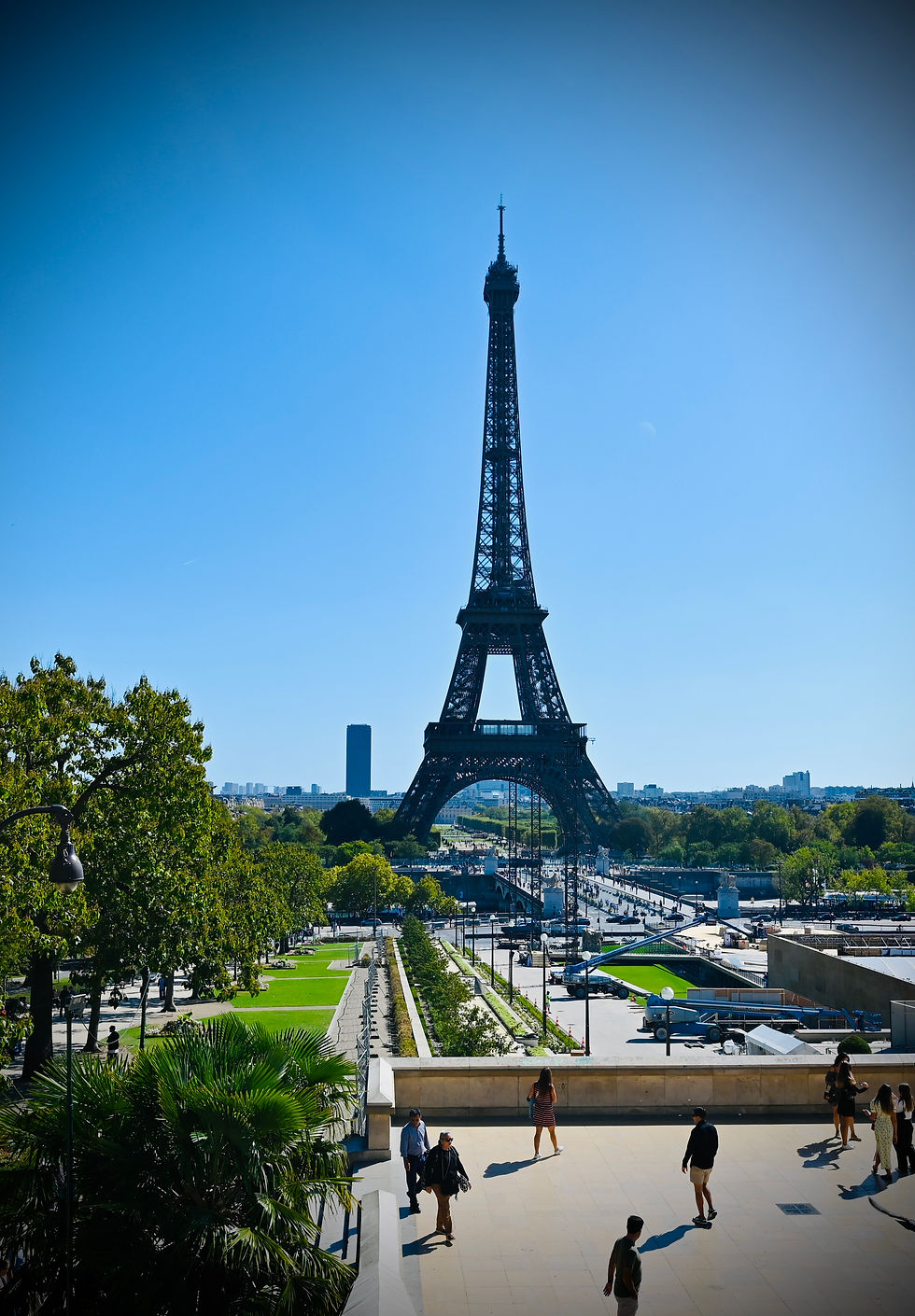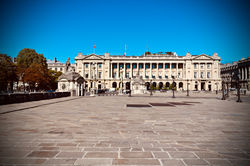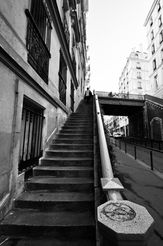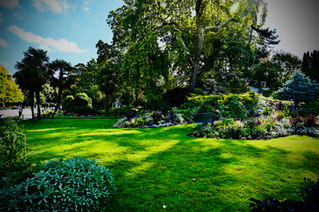
Parisian Daydream: A Serene Walk from Gare du Nord to the Eiffel Tower
Paris has a way of slowing time on a beautiful day. Under a bright blue sky, I set out with my camera and no rigid plan—just the hope of discovering quiet corners, charming streets, and iconic views. It was the kind of sunny stroll that makes you forget the world for a while, immersing you in the simple joy of flâner (strolling) without hurry. The result was a day of peaceful wandering from a bustling train station to the foot of the Eiffel Tower, filled with surprising finds, gentle moments, and plenty of photo opportunities.
Hidden Corners, Bustling Streets, and Towering Views Under a Blue Sky
Paris is a city of contrasts: tranquil squares tucked behind busy boulevards, village-like streets in the middle of the metropolis, and world-famous monuments appearing when you least expect them. On this walk, I experienced all of these. I moved from the hectic energy of Gare du Nord to the calm of neighborhood parks, from lively market streets to majestic landmarks. Each step revealed a new facet of the city’s character, bathed in sunlight. Here’s the journey, with reflections and photography tips at each turn.
 |
|---|
 |
 |
 |
 |
 |
 |
 |
 |
 |
From Gare du Nord to Square Montholon – From Bustle to Oasis
I stepped out of Gare du Nord into the morning light, leaving behind the echo of train announcements and rolling suitcases. The station’s 19th-century facade watched over streams of travelers, its stone sculptures and iron details a backdrop to the city’s daily rhythm. As I walked along Rue de Dunkerque, the rush of commuters and honking taxis gradually faded. Just a few blocks away, I found Square Montholon, a petite park that felt like a secret haven amid the urban buzz. Locals relaxed on benches under the shade of century-old chestnut trees, and children’s laughter rose from a small playground. The air here was calmer, filled with the chirping of birds instead of traffic. I took a deep breath and let the peaceful atmosphere set the pace for my day.


Photo tip: Capture the contrast between motion and stillness. At busy hubs like Gare du Nord, try framing a moving crowd against the station’s grand arches or glass roof. A slight blur of people in motion can convey energy, while the architecture stays crisp. Then, in quiet spots like Square Montholon, switch gears—focus on a still subject (a person reading on a bench or a flower bed) with the soft blur of the city in the background to emphasize tranquility.
 |  |  |
|---|---|---|
 |  |  |
 |  |  |
 |
Rue des Martyrs – The Village Heart of Paris
Refreshed by my pause in the park, I continued on to Rue des Martyrs, a historic street that climbs gently toward Montmartre. Almost immediately, I was enveloped in a cozy, village-like ambiance. This street is a food-lover’s paradise and a living postcard of Parisian daily life. Artisanal boulangeries sent out the warm aroma of fresh baguettes, colorful pâtisserie displays sparkled in shop windows, and vendors artfully arranged strawberries and asparagus at the produce stands. I joined leisurely locals and a few savvy tourists strolling past fromageries, old bookstores, and cafés spilling onto the sidewalk. Weekend brunch-goers chatted on tiny terraces under striped awnings, and an old man in a beret walked his dog with a baguette tucked under his arm – as quintessential as it gets.
Photo tip: On a bustling market street, sometimes the small details tell the biggest story. Snap close-ups of the vibrant details: the pastel pastries lined up in a pâtisserie, the handwritten chalkboard menu of a café, or a cluster of vintage signs above a boutique. These shots capture the character of Rue des Martyrs. For street scenes, consider stepping back across the street to frame the action – a wide shot of the storefronts with pedestrians creates a lively scene, while a zoom can catch a candid moment (like a vendor smiling during a sale) without intruding.


Did you know? Rue des Martyrs owes its name to an ancient legend. It’s said to be the route where Saint Denis, the first bishop of Paris, was marched to his martyrdom in the 3rd century. According to the story, after being beheaded he remarkably continued walking for a time, carrying his head in his hands, and this miraculous feat gave the street its name junot.fr . Today, thankfully, the only heads you’ll lose on Rue des Martyrs are to the dizzying array of delicious treats and charming sights around every corner.
 |
|---|
 |
 |
 |
 |
 |
 |
 |
 |
 |
 |
 |
 |
 |
 |  |
|---|---|
 |  |
 |  |
 |  |
 |  |
 |  |
 |  |
 |  |
Turning off Rue des Martyrs, I made my way toward the Église de la Sainte-Trinité. The transition was striking: from the intimate scale of a village street, suddenly I faced a grand Parisian square dominated by this 19th-century church’s majestic facade. Its stone bell tower and ornate Second Empire details rose high, presiding over the busy square (it was built between 1861 and 1867 as part of Baron Haussmann’s grand redesign of Paris.
I lingered by the fountain in front, noticing how the sun lit up the church’s rose window and the elegant clock above. Commuters coming out of the Trinité metro station hardly glanced up, but I was in awe of the architectural grandeur that appeared out of nowhere at the end of a neighborhood walk. In that moment, Paris reminded me of its knack for surprise—one minute you’re in a small-town lane, the next you’re gazing at opera-worthy architecture.
Photo tip: To capture tall architectural landmarks like La Trinité, try shooting from a low angle. Standing near the base of the church and pointing your camera upward emphasizes its height and magnificence. If possible, include a bit of the foreground (like the fountain or people passing by) for scale. Alternatively, step back and use the surrounding buildings or trees to frame the church in your shot, which can highlight how this historic structure sits amidst the modern city.

Square des Batignolles – A Village’s Secret Garden
By early afternoon, I ventured west to the Batignolles neighborhood in the 17th arrondissement. Stepping into Batignolles feels like entering a little village woven into Paris. The pace here was unhurried; parents pushed strollers, friends chatted at café tables, and the hum of the city softened to a gentle buzz. I wandered along Rue des Batignolles, passing quirky boutiques and boulangeries, until I reached the heart of the quarter: Square des Batignolles.
Parc Monceau – An Elegant Afternoon Retreat
Continuing my journey of green spaces, I headed a bit further south to Parc Monceau. Entering this park is like stepping into a painting. In fact, the impressionist Claude Monet painted it several times, and I immediately saw why. Parc Monceau is elegance personified: ornate wrought-iron gates open into a landscaped haven of curving walkways, rolling lawns, and a picturesque pond. Around the pond stands a semicircle of Corinthian columns, a remnant of an 18th-century folly that adds a touch of classical romance to the scene. As I walked, I passed under the dappled shadows of plane trees and admired flowerbeds bursting with color. Well-dressed children chased each other under the watch of nannies and grandparents, and joggers made unhurried laps, visibly enjoying the scenery more than the exercise.
I found an empty bench by the pond. The mid-afternoon sun was gentle, casting a golden glow on everything it touched. In the pond’s still water, the ring of ancient columns reflected perfectly, creating a mirror image that felt like a portal to another time. It was a moment to savor – I sat, took a sip of water, and let my mind wander with the clouds. The bustle of the city felt worlds away, even though I was in the heart of one of Paris’s busiest districts. This is the magic of Parc Monceau: a place where you can slow down, surrounded by subtle reminders of history and artistry.
 |  |
|---|---|
 |  |
 |  |
 |  |
 |  |
Photo tip: Parc Monceau offers storybook settings for photos. To capture the classical charm, try framing the Corinthian colonnade and its reflection in the pond. A wide-angle shot here can encompass the curve of columns, the water, and maybe a swan or duck gliding by for added interest. If the light is strong, the reflection will be vivid – consider using a polarizing filter if you have one, to control glare on the water. Also, don’t hesitate to include people in your shots: a couple strolling or a child by the water’s edge can add scale and a human touch to this elegant landscape.
Did you know? Parc Monceau has a flair for drama and innovation. Not only was it landscaped in the 1770s with whimsical features (it once had an Egyptian pyramid, a Dutch windmill, and other curiosities as garden follies), but it also witnessed a world first. In 1797, this park was the landing site of the world’s first parachute jump! André-Jacques Garnerin ascended from Parc Monceau in a hot-air balloon and then jumped from an altitude of about 3,200 feet, using a silk parachute of his own design, to land safely in the park – the first time anyone had ever done such a thing parisianfields.com guinnessworldrecords.com . A small plaque in the park today commemorates this fearless feat. Next time you stroll through Monceau, imagine the astonished onlookers witnessing a man dropping from the sky here over two centuries ago.
 |  |  |
|---|---|---|
 |  |  |
 |  |  |
 |  |  |
 |  |  |
 |  |  |
 |  |  |
 ParisParijs |  |
Esplanade du Trocadéro – Front-Row Views of the Tower
As late afternoon approached, I traded the tranquility of parks for one of Paris’s most spectacular open vistas. I made my way to the Esplanade du Trocadéro, the grand plaza on a hill directly across the Seine from the Eiffel Tower. This is a classic viewpoint that never fails to inspire, especially on a clear, sunny day. As I emerged onto the wide stone esplanade, the Eiffel Tower appeared in full view across the river, its iron lattice aglow in the warm light of the lowering sun. Even after countless postcards and Instagram shots, the scene can take your breath away: the Tower rising bold and proud, the Champ de Mars greens at its feet, and below me, the famous Trocadéro fountains sending up playful bursts of water.
The atmosphere at Trocadéro was lively yet somehow still joyful and relaxing. Tourists and locals alike were scattered about the steps and terraces, all drawn by the magnetic view. I heard a mix of languages—excited exclamations, camera shutters clicking, children giggling as they chased bubbles from a street performer. A newlywed couple in wedding attire posed for photos with the Tower as their backdrop, and a group of skateboarders practiced tricks off to one side, weaving the ordinary into the extraordinary setting. I found a spot on the stone railing and simply soaked it all in, feeling the golden sunlight on my face. After the quiet of Batignolles and Monceau, the grand scale of Trocadéro and the iconic Eiffel Tower felt like a triumphant finale. Yet, even among the crowd, I sensed a shared calm—people were unhurried, content to linger and let the moment imprint itself in memory.

Photo tip: Trocadéro is the ultimate Parisian panorama, so think in layers when composing your shot. A wide-angle lens will let you capture the foreground (perhaps the fountains or the bronze statues that flank the esplanade), the Eiffel Tower prominently in the mid-frame, and the sky above. If you’re there at golden hour (highly recommended), the light will be soft and warm; this is perfect for creating long shadows and a radiant glow on the Tower. Try to include some of the human element – a silhouette of a couple admiring the view or a child holding a balloon can add a storytelling touch to your photo. And for a fun perspective, consider kneeling down to ground level and using the patterned floor of the esplanade or the steps as leading lines guiding the eye toward the Eiffel Tower.


















Pont de Bir-Hakeim Framing the Iron Lady
Photo tip: Pont de Bir-Hakeim is all about composition and leading lines. Use the repeating iron arches of the bridge to draw the viewer’s eye straight to the Eiffel Tower in the distance. Position yourself in the center of the walkway for a perfectly symmetrical shot, or off to the side to include the curved lampposts and that France Renaissante statue as interesting foreground elements. If a train crosses, snap the shot – the motion blur of the train can add a sense of liveliness to the still architecture. And if you’re comfortable with post-processing, a slightly lower exposure can emphasize the pattern of light and shadow that the setting sun creates through the lattice of the bridge.
Did you know? The Pont de Bir-Hakeim was originally called the Pont de Passy when it was built in 1905, but it was renamed in 1948 to honor a World War II battle where Free French forces fought in Libya en.wikipedia.org . Beyond its historical name, the bridge has become a pop culture icon: its cinematic looks made it a filming location for movies such as Last Tango in Paris and Christopher Nolan’s Inception. If you’ve seen the dreamy Paris bridge scene in Inception, that was Bir-Hakeim – the spot where reality bends in a dream. It’s a favorite not just of filmmakers but also of photographers, offering one of the most enchanting frames for the Eiffel Tower in the entire city.
After enjoying the sweeping view from Trocadéro, I descended the stairs and crossed the Seine to another famous vantage point: the Pont de Bir-Hakeim. This two-level bridge (metro trains rumble overhead while pedestrians and cars use the lower deck) is an architectural beauty in its own right and offers a dramatically framed view of the Eiffel Tower. The sun was beginning to edge toward the horizon, and the sky was painted with late-day hues of pale orange and blue. Walking beneath Bir-Hakeim’s line of perfectly symmetrical iron arches, I felt like I had stepped onto a movie set — unsurprising, since this bridge’s unique design has been featured in films like Inception for its dream-like visuals.
Mid-bridge, I paused where a striking statue of a horseman (aptly named "La France Renaissante") rears up, seemingly toward the Eiffel Tower itself. From this spot, the Tower stood framed by the metal columns of the bridge, creating a natural focal point for photographs. A few other photographers had gathered here, each waiting to capture that ideal shot of Paris’s Iron Lady in a steel embrace. As I waited for a metro train to pass on the upper deck (which adds a dynamic element to photos), I looked around at the scene: a couple taking wedding photos under the archway, a cyclist crossing with groceries in her basket, the gentle waves of the Seine below catching the evening light. It was one of those quietly profound moments where the city felt both grand and intimate at once.
 |  |  |
|---|---|---|
 |  |  |
 |  |  |
 |  |  |
 |  |  |
 |  |  |
 |  |  |
 |
Final Frame
By the time I took my last photo on the bridge, dusk was settling in. I headed back towards the city center with a full memory card and an even fuller heart. Paris had given me a day of both discovery and calm – a chance to explore without rush, to notice the little details, and to feel the grand beauty of the city afresh. I wandered through the evening streets, passing lively brasseries starting to fill up, and found myself in the heart of Paris once more, near the Seine. The street lights were flickering on, and I couldn’t resist a few final shots of the city’s lights reflecting on the water, the silhouettes of Parisian rooftops against the purple sky.This walk reminded me why Paris is endlessly captivating: it’s not just the famous landmarks, but the way serendipity awaits on every corner.
From a quiet square where I could hear my own thoughts, to the top of Trocadéro where I shared an awe-struck silence with hundreds of strangers, each moment felt like a gift. In one day, I experienced Paris in its many moods – intimate, local, historic, and spectacular. Every step told a story, every glance became a photograph in my mind. And as I finally tucked my camera away and surrendered to the dusk, I felt a deep sense of peace. It had been a day to remember, a sunny Parisian daydream turned reality, reminding me (and I hope, reminding you) that sometimes the best itinerary is to simply walk and let Paris unveil itself, frame by frame, wonder by wonder.

 |  |  |
|---|---|---|
 |  |  |
 |  |  |
 |  |  |
 |  |  |
 |  |  |
 |  |  |
 |  |  |
 |  |  |
 |  |  |
 |  |

Be the first to know
Subscribe to our newsletter to receive news and updates.















